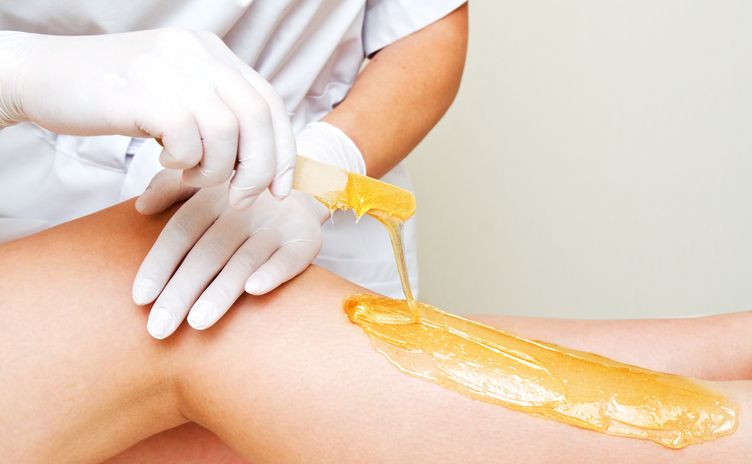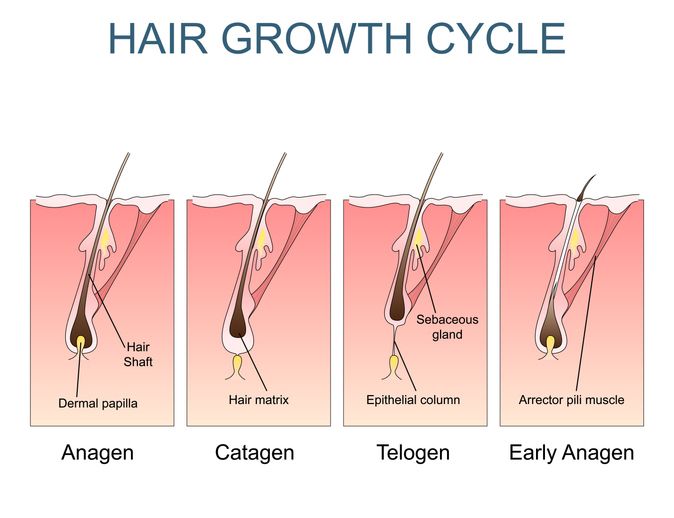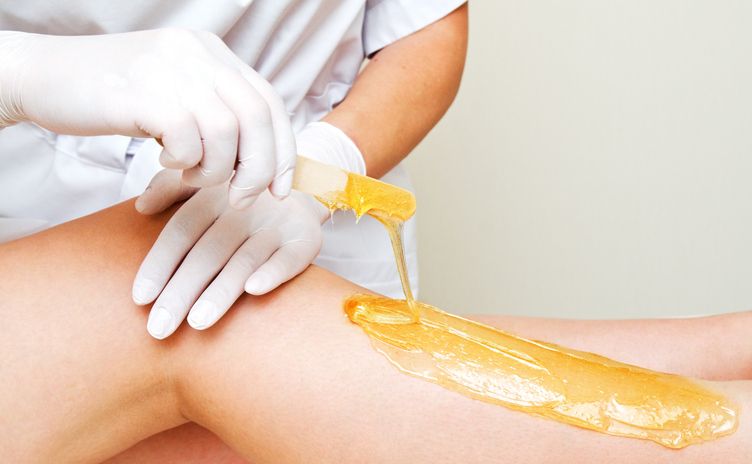- Home
- Trend
- Weight Loss Strategies
- Acne Tips
- Hair Health Information
- Blemish Removal Tips
- Acne Scar Removal Tips
- Muscle Building Techniques
- Intimate Care Tips
- Postpartum Intimate Care
- Eye Bags Wiki
- Tips for Face Slimming
- Secret of Permanent Hair Removal
- Breast Enlargement Tips
- Cure to Snoring
- Marionette Lines
- Skin-Tightening Secrets
In a world where smooth, hairless skin is often equated with beauty, many women find themselves battling against an age-old adversary: unwanted body hair. This struggle is more than just a cosmetic concern; it can be deeply intertwined with a woman's self-esteem, social interactions, and overall well-being. One of the most challenging conditions contributing to excessive body hair is hirsutism, a medical condition where women experience hair growth in areas that are typically reserved for men, such as the face, chest, and back.
The Relationship Between Hirsutism and Women's Body Hair

Hirsutism is not merely a superficial issue. It is a condition that reflects underlying hormonal imbalances, often linked to polycystic ovary syndrome (PCOS), which affects a significant percentage of women globally. Essentially, hirsutism is an excessive hair growth pattern that is androgen-dependent, meaning it is driven by hormones typically associated with male characteristics. For many women, this condition is a daily battle, one that modern hair removal treatments seek to address.
To understand hirsutism and the struggles women face, we must delve into the biological processes that dictate hair growth. Body hair, while often seen as unwanted, is a natural part of human physiology. It serves several purposes, including protecting the skin, regulating body temperature, and even playing a role in pheromone communication.
What Changes The Structure?
However, when hormone levels fluctuate, especially during conditions like PCOS, the body may produce excess androgens—male hormones like testosterone. These hormones stimulate the hair follicles, causing hair to grow in patterns more common to men. This hair growth can be thick, coarse, and dark, appearing in areas such as the face, chest, back, and buttocks.
The hair follicles, tiny structures located beneath the skin, are the starting point for hair growth. Each follicle is a complex organ that goes through a cycle of growth, rest, and shedding. Hormones significantly influence this cycle, particularly in cases of hirsutism, where the growth phase may be prolonged, leading to thicker and more persistent hair. Here are some common signs:
• Facial hair: This includes a moustache, beard, chin hair, or sideburns.
• Chest hair: Hair growth on the chest, especially in a male pattern.
• Back hair: Hair growth on the back, often in a V-shape.
• Abdominal hair: Hair growth on the abdomen, often in a male pattern.
• Inner thigh hair: Hair growth on the inner thighs.
• Buttock hair: Hair growth on the buttocks.
• Arm hair: Thick, coarse hair on the arms.
Hirsutism can be distressing, as it not only affects a woman's physical appearance but also her psychological health. The condition can lead to social anxiety, depression, and a diminished quality of life. Women with hirsutism may feel self-conscious, avoiding social situations or spending considerable time and resources on hair removal.
Modern Solutions to an Age-Old Problem: Hair Removal Treatments
For centuries, women have sought ways to remove unwanted hair. From ancient methods like sugaring and threading to modern-day laser hair removal, the pursuit of smooth skin is a testament to the ongoing battle against unwanted body hair. Today, the options for hair removal are more varied and sophisticated than ever, offering women numerous ways to manage hirsutism and regain confidence.
Thankfully, when it comes to hair removal, women have a plethora of options at their disposal. These range from temporary solutions, such as shaving and waxing, to more permanent methods like laser hair removal and electrolysis.
Shaving and Waxing
These are the most common methods used for hair removal. Shaving involves cutting the hair at the skin's surface, which can lead to quick regrowth and potential side effects such as razor burn and ingrown hairs. - Waxing, on the other hand, removes hair from the root, leading to smoother skin for a longer period. However, waxing can be painful and may cause skin irritation, particularly for those with sensitive skin.
Hair Removal Cream
Over-the-counter creams are another option for those looking to remove hair at home. These creams work by breaking down the hair's protein structure, allowing it to be wiped away. While convenient, these creams can cause skin irritation or allergic reactions in some individuals.
Sugaring
Sugaring is a method similar to waxing, where a sticky paste made from sugar, lemon, and water is applied to the skin. It adheres to the hair and is removed in the direction of hair growth. Sugaring can be less painful than waxing and is often considered gentler on sensitive skin. However, it may require some practice to perfect the technique and can be less effective on shorter hairs.
Threading
Threading involves using a twisted thread to trap and remove hair from the follicle. It is particularly effective for small areas like the eyebrows and upper lip. Threading offers precise control and is less irritating than some other methods. However, it can be uncomfortable, and its effectiveness may vary depending on hair thickness and growth patterns.
Electrolysis
For those seeking a more permanent solution, electrolysis is a method that involves inserting a tiny needle into the hair follicle and applying an electrical current to destroy it. This method is effective but time-consuming, as each hair follicle must be treated individually. However, electrolysis can be really painful and may result in scarring or skin discoloration.
免費體驗
S6 Body Sculpting Treatment
1 Minute Self-Registration
Date should not be before minimal date
A3 Hair Removal Treatment: A Long-Term Solution for Unwanted Body Hair

Among the most advanced and effective methods available today is laser hair removal. This treatment uses focused light energy to target and destroy hair follicles, leading to a significant reduction in hair growth. Laser hair removal is particularly effective for those with darker hair and lighter skin, though advancements in technology have made it accessible to a wider range of skin tones and hair colours.
In the field of laser hair removal, the A3 Hair Removal Treatment stands out as a premier option for women struggling with hirsutism. This treatment offers a long-term solution to the problem of unwanted body hair, combining advanced technology with a focus on comfort and effectiveness.
The A3 Hair Removal Treatment utilises a sophisticated laser system that targets the hair follicles without damaging the surrounding skin. This precision allows for effective hair removal across various areas of the body, including the face, arms, legs, chest, and back. Unlike traditional hair removal methods, which may only provide temporary relief, the A3 treatment offers a more permanent reduction in hair growth.
One of the key benefits of the A3 Hair Removal Treatment is its ability to treat large areas of the body quickly and efficiently. This makes it an ideal choice for women dealing with widespread hirsutism, where traditional methods might be too time-consuming or ineffective. Additionally, the treatment is designed to minimise discomfort, with many patients describing the sensation as a mild tingling or warming of the skin.
The A3 Hair Removal Treatment is also versatile, capable of treating various skin types and hair colours. This inclusivity is crucial, as hirsutism affects women of all backgrounds. By offering a solution that works across different skin tones and hair types, the A3 treatment provides hope for women who have struggled to find effective hair removal options in the past.
The Science Behind A3: How It Works
At the core of the A3 Hair Removal Treatment is laser technology that targets the melanin in hair follicles. Melanin, the pigment responsible for hair colour, absorbs the laser's light energy, which is then converted into heat. This heat damages the follicle, inhibiting future hair growth without harming the surrounding tissue.
The treatment is administered in sessions, with each session targeting a percentage of hair follicles. Over time, this leads to a significant reduction in hair growth, with many patients experiencing long-lasting results. The number of sessions required can vary depending on the area being treated, the density of hair, and individual factors such as hormone levels.
One of the standout features of the A3 Hair Removal Treatment is its ability to provide results that are both noticeable and enduring. While other hair removal methods may require constant upkeep, the A3 treatment offers a more permanent solution, reducing the need for frequent shaving, waxing, or other temporary methods.
Beyond Hair Removal: Addressing the Underlying Causes
While hair removal treatments can help manage hirsutism, they do not address the underlying hormonal imbalances that often cause the condition. If your hirsutism is a symptom of polycystic ovary syndrome (PCOS), managing this condition can help reduce excess hair growth.
Some potential treatments for hirsutism include:
Hormone Therapy: Hormone therapy is often the first line of treatment for hirsutism caused by hormonal imbalances. Medications such as anti-androgens can help lower the levels of male hormones in the body, thereby reducing hair growth. Anti-androgens like spironolactone work by blocking androgen receptors, preventing the hormones from binding to hair follicles and stimulating hair growth.
Birth Control Pills: Oral contraceptives, commonly known as birth control pills, are another effective treatment for managing hirsutism. These pills contain a combination of oestrogen and progestin, which work together to reduce the production of androgens by the ovaries. In addition to regulating menstrual cycles, birth control pills can help decrease the severity of hirsutism by lowering androgen levels and reducing hair growth.
Insulin-Sensitising Agents: For women with PCOS, insulin resistance is a common issue that can exacerbate hormonal imbalances. Medications such as metformin, which are typically used to treat diabetes, can improve insulin sensitivity and, in turn, reduce androgen levels. By addressing insulin resistance, these medications can help mitigate symptoms of hirsutism.
Lifestyle Changes: Lifestyle modifications, such as maintaining a healthy diet and engaging in regular physical activity, can also play a significant role in managing PCOS and hirsutism. Weight loss, even in small amounts, can help lower insulin levels and improve hormonal balance, potentially reducing excess hair growth.
Consultation with an Endocrinologist: For those experiencing severe hirsutism or symptoms of PCOS, it is advisable to consult an endocrinologist. These specialists can conduct thorough evaluations, including blood tests to measure hormone levels, and develop a personalised treatment plan that may include a combination of medications and lifestyle interventions.
Natural Remedies and Supplements: Some people may explore natural remedies and supplements to manage hirsutism. For example, spearmint tea has been suggested to have anti-androgenic effects, potentially reducing hair growth over time. Additionally, supplements like inositol, which supports insulin sensitivity, may be beneficial for women with PCOS. However, it's important to approach natural remedies with caution and consult a healthcare provider before starting any new supplements.
Final Thoughts on Managing Hirsutism: Hirsutism is Not Mayday
In this journey, treatments like the A3 Hair Removal Treatment are valuable tools, offering women the opportunity to take control of their bodies and their appearance on their own terms. Some women may opt to accept their natural body hair as a symbol of self-acceptance and empowerment. This decision can be a powerful statement against societal beauty standards, challenging the notion that hairlessness is a prerequisite for femininity.
Regardless of the choice made, the most important factor is that it is an informed and empowered decision. Women should feel confident in their ability to select what is best for their bodies, whether that means undergoing hair removal treatments or embracing their natural hair.
A3 Laser Hair Removal Treatment免費體驗
S6 Body Sculpting Treatment
1 Minute Self-Registration
Date should not be before minimal date
FAQ

1. In short, what is hirsutism, and how does it affect women?
Hirsutism is a condition where a woman experiences excessive hair growth in areas where men typically grow hair, such as the face, chest, and back. This growth is often a result of increased levels of androgens, which are male hormones present in both men and women. The condition can be particularly distressing for women, as it can lead to unwanted hair all over the body. If you have hirsutism, you may need to consult a healthcare provider to understand the underlying causes and explore effective treatment options.
2. How can women get rid of unwanted body hair caused by hirsutism?
Women dealing with hirsutism have several options to get rid of unwanted body hair. Depilatory creams are one method that can dissolve hair at the skin's surface, offering a temporary solution. However, these creams may need to be used frequently to maintain smooth skin. For longer-lasting results, laser hair removal or electrolysis might be considered, especially for the removal of hair all over the body. It's important to discuss these options with a healthcare provider to determine the best approach for your specific situation.
3. Can depilatory creams cause scar tissue when used to remove unwanted body hair?
While depilatory creams are generally safe for the removal of unwanted body hair, they can sometimes cause skin irritation or allergic reactions, especially if used improperly. This irritation can lead to inflammation and, in rare cases, the formation of scar tissue. To minimise risks, it is essential to do a patch test before using any depilatory cream. If you have sensitive skin or are prone to reactions, you may need to explore other hair removal methods.
4. What are the treatment options for women who have hirsutism and want to reduce hair growth?
Women with hirsutism have several treatment options to manage and reduce hair growth. Hormonal treatments, such as birth control pills or anti-androgen medications, can help regulate hormone levels and reduce the growth of unwanted hairs. Additionally, laser hair removal offers a more permanent solution by targeting the hair follicles, slowing down or stopping hair growth over time. If you have hirsutism, it's crucial to consult a healthcare provider to discuss the most effective treatment options based on the severity of your condition and your overall health.
5. If you have hirsutism, what should you consider before choosing a hair removal method?
If you have hirsutism, it's important to consider the effectiveness, safety, and potential side effects of different hair removal methods. For instance, while depilatory creams can provide quick results, they may cause irritation for some people. Laser hair removal offers a more long-term solution, but it may require multiple sessions. You may need to weigh the pros and cons of each method, and possibly consult a dermatologist to find the best approach for your skin type and the extent of hair growth.









